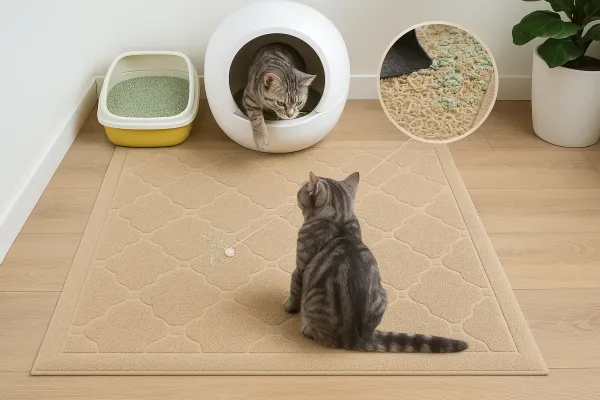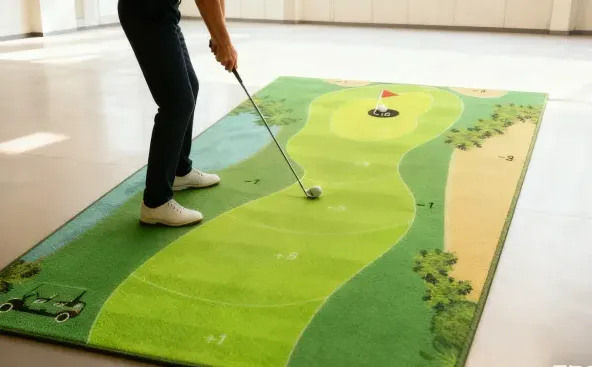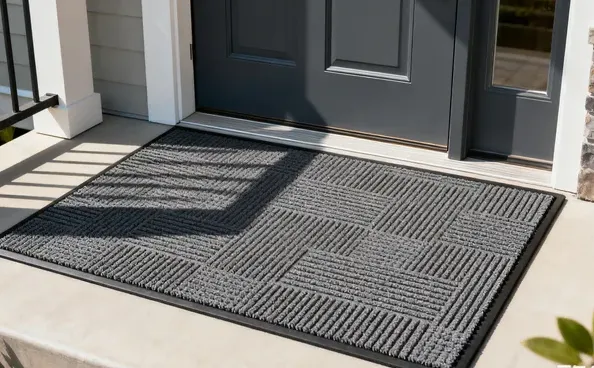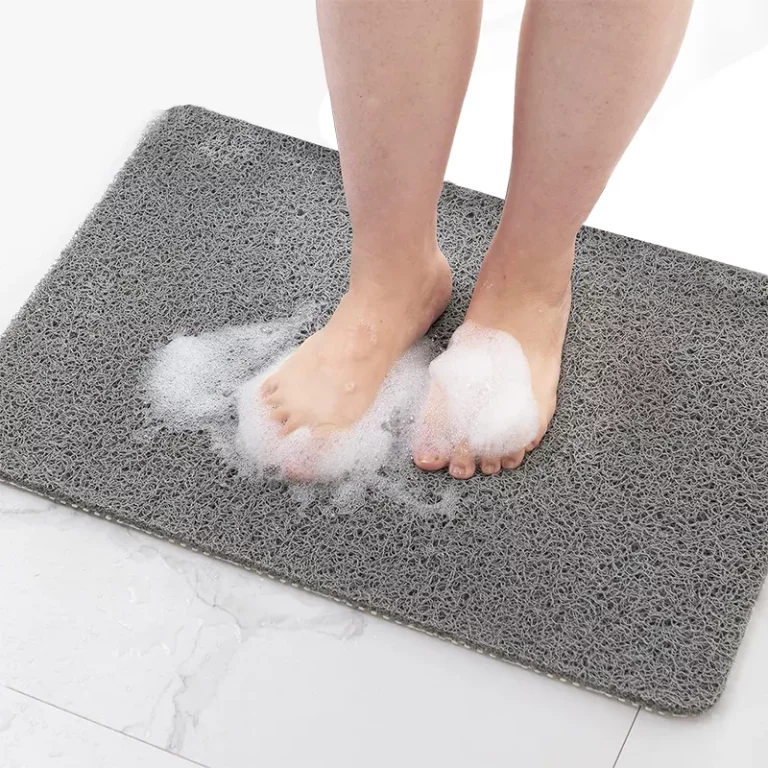Tired of finding tiny grains of cat litter scattered across your floors, far from the litter box? It’s a constant battle, making floors feel gritty and requiring endless sweeping. This litter tracking isn’t just messy; it’s a daily frustration for cat owners, turning clean floors into a distant memory . Wouldn’t a simple, effective solution be amazing?
Yes, cat litter mats absolutely work by effectively trapping litter granules that cling to your cat’s paws as they exit the litter box. These mats work using specialized textured surfaces, deep grooves, or innovative honeycomb patterns specifically engineered to dislodge and catch litter particles. Placing the right cat litter mat strategically around the litter box significantly reduces the amount of scattered litter tracked throughout your home, keeping litter contained and making cleanup much easier. This makes them one of the best cat litter mat solutions available for maintaining a cleaner home in 2025.

What Exactly is a Cat Litter Mat and How Does It Function?
Think of cat litter mats as specialized doormats, but engineered specifically for your feline friend’s litter box area. Their primary mission? To trap litter particles clinging tenaciously to your cat’s paws after using the litter box. It’s a simple concept: when your cat walks out of the litter box, their paws inevitably carry tiny pieces of cat litter. Without a barrier, this bit of litter gets tracked everywhere – onto carpets, hardwood floors, even furniture!
The real ingenuity lies in the mat’s construction. Most cat litter mats feature specific textures, patterns, or materials chosen precisely for their ability to gently scrape or brush litter off your cat’s paws before they get far. Common, effective designs include:
-
Mesh or Loop Mats: Often utilizing materials like PVC (check out these cat mat for litter box), these mats create a web-like or “spaghetti” surface. As the cat walks across, the loops gently spread their paw pads, causing loose litter granules to dislodge and fall into the mat’s structure, trapping them effectively.
-
Honeycomb Mats: These popular mats typically boast a dual-layer litter mat design. The top layer features holes (often hexagonal, hence “honeycomb”) that allow litter to fall through cleanly to a solid bottom layer. This design is highly effective at trapping much litter and, crucially, keeping it out of sight until cleaning time. Think of designs like the blackhole litter mat.
-
Ribbed or Grooved Mats: These mats work by using raised ridges or deep grooves that physically brush the litter off paws. The collected litter and debris settle neatly into the channels between the ribs, keeping the top surface clearer.
Essentially, the mat is designed to catch as much litter as possible, right at the source. As custom mats manufacturing plants, we’ve honed the science behind material selection and pattern design to create mats that truly deliver on this promise – a litter mat that works.
Do All Cat Litter Mats Work Equally Well?
No, definitely not. While most mats will catch litter to some degree, their effectiveness can vary significantly. Think of it like choosing tires for a car – different treads work better in different conditions. Similarly, the best cat litter mat depends on:
-
Design: Honeycomb vs. Mesh vs. Ribbed.
-
Material: PVC, EVA, Silicone, Rubber – each has pros and cons for trapping and durability.
-
Size: Needs to be large enough for the cat to step on it properly.
-
Type of Litter: Fine-grain cat litter might require a different mat design (e.g., smaller holes, denser mesh) compared to larger pellets or crystals.
Mats with deeper trapping mechanisms, like the Pieviev cat litter mat or iPrimio cat litter trapper styles (honeycomb), often excel because they allow litter falls through the top layer. This keeps the surface cleaner for subsequent exits and effectively hides the litter trapped below. Mesh or loop mats, including the well-known Gorilla Grip cat litter mat, rely on surface texture. Their success depends on loop density and how well the material flexes to dislodge litter particles. Premium options like the PetFusion ToughGrip cat litter mat are noted for combining durability with excellent trapping ability.
Finding the absolute best cat litter mat involves matching the mat’s features to your specific needs. Consider:
-
Does your cat dig enthusiastically, sending litter flying?
-
Do they tend to leap out of the box?
-
What type of litter do you prefer?
-
How much priority do you place on ease of cleaning?
As manufacturers, we produce a wide array, including cat litter mats of 2025 trends, focusing on quality materials to ensure there’s a high-performing litter mat that works for almost every cat owner.
How Effective Are Cat Litter Mats at Reducing Litter Tracking?
Highly effective! While perfection (zero tracked litter) is unlikely, a good quality cat litter mat makes a dramatic difference. Many cat owners report an estimated 70-90% reduction in scattered litter found around their homes after implementing a suitable mat. The primary goal is achieved: contain litter near the cat litter box.
The mat’s effectiveness hinges on its dual ability to dislodge litter from paws and hold that litter until you clean it. A well-designed cat litter mat will catch the vast majority of the litter that would otherwise migrate onto your floors and furniture. This isn’t just anecdotal; the reduction in litter tracking is consistently cited as the top benefit by users.
Impact:
-
Less Cleaning: Significantly reduced need for daily sweeping/vacuuming around the litter box area.
-
Cleaner Home: Floors feel cleaner underfoot, reducing that gritty sensation.
-
Less Stress: Minimizes a common frustration point for cat owners.
For our B2B clients (Retailers, E-commerce Sellers), highlighting this proven effectiveness is key. Features maximizing trapping – deep grooves, dual layers, optimal textures – translate directly into customer satisfaction because the mat did well in controlling the kicked-up litter.
What Types of Cat Litter Mats Are Most Effective? (e.g., Honeycomb, Mesh, Ribbed)
While effectiveness can be subjective and depend on the specific cat and litter, certain types consistently rank high in performance tests and user reviews:
| Mat Type | Trapping Mechanism | Pros | Cons | Often Good For… |
| Honeycomb (Dual-Layer) | Litter falls through holes in top layer to bottom | Excellent trapping & hiding; easy pour-out cleaning; keeps surface clean | Can be bulkier; potentially less durable top layer (EVA) | Most litter types, tidy appearance |
| Mesh/Loop (PVC) | Textured loops brush & trap litter within fibers | Durable; often water-resistant; good scraping action; flexible | Litter can get embedded; may require rinsing/shaking | Coarser litters, high-traffic areas |
| Ribbed/Grooved | Channels collect litter scraped by ridges | Good scraping; often very durable (rubber/silicone); defined channels | Effectiveness depends on groove depth; may not hide litter | Cats that don’t dig excessively |
Honeycomb mats (similar to Pieviev cat litter mat or iPrimio cat litter trapper) are frequently lauded as the most effective overall because they actively contain litter out of sight. Mesh mats like the Gorilla Grip cat litter trapping mat are workhorses, known for their scrubbing action. Ribbed mats offer a straightforward trapping method.
The best cat litter mat often merges design with material science. As manufacturers, we offer various styles, including sustainable options like cat litter box mats, ensuring a fit for every need.

How Do Popular Mesh/Loop Style Litter Mats Perform?
Many popular and effective cat litter mats utilize a mesh or loop design, often referred to as a grip cat litter trapping mat style due to their texture and non-slip properties. These mats gain positive feedback for their reliable performance in reducing litter tracking.
Performance Highlights of Quality Mesh/Loop Mats:
-
Effective Trapping Action: Their dense, often “spaghetti-like,” texture is specifically designed to gently scrape and effectively grab litter particles from a cat’s paws as it walks across. Many cat owners report a significant, noticeable decrease in tracked litter around the home.
-
Durable Material: Quality versions are typically made from durable PVC or similar resilient materials. This construction aims to be soft enough for feline paws yet tough enough to dislodge stubborn cat litter granules effectively.
-
Essential Non-Slip Backing: A strong non-slip backing is crucial. This feature keeps the mat securely in front of the litter box, preventing it from shifting and ensuring it’s always positioned to catch litter.
Common user feedback often sounds like: “It stays put, and it definitely catches most of the litter my messy cat kicks out.” However, it’s worth noting that very fine cat litter might sometimes work its way deep into the mesh structure. This can make cleaning slightly more involved compared to mats with open layers, often requiring vigorous shaking, thorough vacuuming, or rinsing. Nonetheless, the widespread use of this mat style suggests it offers a compelling balance of effectiveness, durability, and value for many households dealing with cat litter.
Can Using a Litter Mat Make Cleaning Easier Around the Litter Box Area?
Absolutely, yes! This is arguably one of the biggest practical benefits and a huge relief for cat owners. By concentrating the vast majority of escaped cat litter onto the mat itself, it transforms the cleaning process for the area around the litter box.
The Difference is Clear:
-
Before Mat: Often involves daily sweeping or vacuuming a wide, gritty radius around the litter box. Frustrating!
-
After Mat: Cleaning focuses primarily on the mat itself, saving significant time and effort.
Cleaning Methods by Mat Type:
| Mat Type | Typical Cleaning Process | Ease Level |
| Honeycomb Mats | Lift mat, separate layers, pour trapped litter into trash or back into the litter box, wipe/rinse. | High |
| Mesh/Loop Mats | Shake vigorously outdoors, vacuum thoroughly, rinse with water for deeper cleaning. | Medium |
| Ribbed/Grooved | Shake out litter, vacuum channels, wipe or rinse as needed. | Medium |
By containing the mess on the mat, these products significantly reduce the daily chore load. This mat helps maintain a consistently tidier litter box area with far less effort, preventing that awful feeling of finding litter everywhere. This convenience is a major selling point for consumers and a key benefit for retailers to emphasize when showcasing cat litter mat options.
What Should Importers Look for When Sourcing the Best Cat Litter Mats for 2025?
For our valued B2B partners – Importers, Distributors, Retail Chains, E-commerce Sellers – sourcing the best cat litter mats for the upcoming 2025 market means focusing on quality, function, and reliability. Here’s what to prioritize:
-
Proven Effectiveness: Stock designs demonstrated to trap litter effectively. This includes well-engineered Honeycomb, quality Mesh, and deep-Grooved mats. Offering variety caters to diverse consumer needs and cat litter types.
-
High-Quality Materials: Insist on durable, non-toxic, and pet-safe materials. Common high-performance options include PVC, EVA, Silicone, and TPE. Superior quality leads to higher customer satisfaction and fewer returns.
-
User-Friendly Cleaning: Easy to clean is a non-negotiable for most consumers. Look for mats that are simple to shake out, vacuum, pour out, or rinse. Features facilitating easy cleaning are strong selling points.
-
Optimal Size & Grip: Offer a range of sizes, including options for large litter boxes or multi-cat households. A robust non-slip backing is absolutely essential for functionality and safety.
-
Sustainability Focus: Consumer demand for eco-conscious products continues to grow. Including options like litter tray mats made from recycled or sustainable materials is becoming increasingly important.
-
Customization & Branding: Partner with custom mats manufacturers, like us, who offer private label options. Customizing size, color, pattern, and adding your branding helps your products stand out in a competitive market. Explore possibilities within our general pet mats range and beyond.
-
Manufacturer Reliability: Choose a manufacturing partner known for:
-
Consistent quality control from batch to batch.
-
Scalable production capacity to meet your order volumes.
-
Adherence to ethical manufacturing standards.
-
Clear, responsive communication.
-
Successful sourcing involves a keen eye for performance, durability, user convenience, market trends (like sustainability), and building a strong relationship with a dependable supplier factory.

Are There Downsides? What If My Cat Refuses to Use a Litter Mat?
While overwhelmingly beneficial, cat litter mats aren’t without potential minor challenges. The most common issue? Cat acceptance. Some felines, especially those with sensitive paws or fussy natures, might initially avoid stepping on the new texture. If a cat tends to leap over the mat entirely, its purpose is defeated.
Troubleshooting Mat Avoidance:
-
Material Choice: Opt for softer materials first. EVA foam or silicone are often gentler than stiff PVC mesh. Look for mats specifically marketed as ‘soft touch’.
-
Scent Acclimation: Leave the mat near the litter box for a few days before placing it directly in the exit path. Let the cat get used to its presence and smell.
-
Positive Reinforcement: Place treats or catnip on the mat to encourage your cat to step onto it willingly. Reward them when they do.
-
Size Matters: Ensure the mat is large enough that it’s difficult to avoid entirely.
-
Texture Trial: If one type (e.g., mesh) is rejected, try a completely different texture (e.g., honeycomb). Your cat likes what it likes!
-
Cleanliness: Keep the mat clean! A dirty, smelly mat is uninviting. Clean the mat regularly.
Another minor ‘downside’ can be the cleaning process itself, depending on the mat. Deeply embedded litter in some mesh types might require more scrubbing than simply emptying a honeycomb mat. However, this effort is almost always significantly less than cleaning scattered litter from floors and carpets daily. These hurdles are usually surmountable with patience and the right product choice.
Beyond Trapping Litter, What Other Benefits Do These Mats Offer?
The primary job is clear: trap litter. But quality cat litter mats bring several bonus advantages to the table:
-
Ultimate Floor Protection: Acts as a crucial barrier, safeguarding expensive hardwood, tile, or carpet from:
-
Scratches from claws.
-
Urine misses or spray (especially if your cat sometimes aims poorly missing the litter box).
-
Spills from water bowls placed nearby.
-
Many mats are often made from waterproof/water-resistant materials like PVC. Check out these durable PVC litter mats for cats.
-
-
Improved Hygiene: By containing litter and potential accidents, they contribute to a cleaner, more sanitary litter box area.
-
Zone Definition: Placing a mat next to the litter box helps visually define the “toilet zone,” keeping associated tools (scoops, waste bins) tidy.
-
Potential Comfort: Softer mats can offer a more pleasant transition for sensitive paws stepping out of granular litter.
-
Aesthetic Upgrade: Let’s face it, scattered litter isn’t stylish. With various colors and patterns, you can often find a mat that matches your home décor, improving the look of the litter box area. We offer customization to achieve this!
These added benefits make cat litter mats a multi-functional asset for any cat parent striving for a cleaner, more protected, and aesthetically pleasing home. The mat also serves these valuable secondary roles.
How Do I Choose the Right Size and Material for My Needs (and My Cat)?
Selecting the optimal size and material is key to maximizing effectiveness and ensuring your cat actually uses the mat.
Choosing the Right Size:
-
Observe: Watch how your cat typically exits the litter box. Do they step out carefully? Leap? Turn around?
-
Measure: Note the dimensions of your cat’s litter box and the available floor space in front of the litter box.
-
Prioritize Coverage: Aim for a mat large enough that your cat must take at least 1-2 steps on it to leave the immediate litter box area. When in doubt, go larger. A large litter mat provides more opportunity to catch litter.
-
Consider Multiple Boxes: If you have three litter boxes or more, ensure adequate mat coverage for each, perhaps using individual mats or one extra-large one.
Choosing the Right Material:
| Material | Key Characteristics | Best For | Considerations |
| PVC | Durable, water-resistant, easy to clean, common for mesh | High traffic, durability focus, budget-conscious | Can feel ‘plasticky’ initially |
| EVA Foam | Lightweight, very soft, good trapping (honeycomb) | Paw sensitivity, excellent trapping, quiet | Less resistant to sharp claws |
| Silicone | Flexible, waterproof, non-slip, soft, easy to deep clean | Paw sensitivity, hygiene focus, premium feel | Can be pricier |
| Rubber | Very durable, excellent grip, good for textured mats | Maximum durability, non-slip essential | Can be heavy, may have initial odor |
| Fabric | Soft, absorbent | Extremely sensitive paws (maybe as secondary layer) | Harder to clean, less effective trapping |
Key Questions to Ask Yourself:
-
What’s my top priority: maximum trapping, durability, paw comfort, or ease of cleaning?
-
What type of litter do I use (fine, coarse, pellets)? This impacts trapping.
-
How sensitive are my cat’s paws? (A major factor for cat likes)
Getting the size and material right ensures that your cat is comfortable and the mat will help stop the spread of cat litter.
Frequently Asked Questions (FAQs)
Do cat litter mats really stop litter tracking?
Yes, high-quality cat litter mats significantly reduce litter tracking – often by a large percentage. They trap litter near the box, preventing most of it from spreading. While not 100% foolproof (especially with vigorous leapers!), they make a huge difference.
What is the best type of mat to catch cat litter?
Honeycomb (dual-layer) and dense mesh/loop mats are typically the most effective. Honeycomb mats excel at hiding litter, while mesh provides good scraping action. The best cat litter mat depends on your specific cat litter type and cat’s habits.
How big should a cat litter mat be?
It should be large enough to force your cat to take at least one or two full steps on it upon exiting the litter box. Measure your space and consider your cat’s exit style. Bigger is generally better.
How often should you clean a cat litter mat?
Shake out or empty collected litter every 1-3 days. Perform a more thorough clean (vacuum, rinse, wipe) weekly or bi-weekly, or immediately if soiled with urine or feces. Consistent cleaning maintains effectiveness and hygiene.
Can cat litter mats damage hardwood floors?
Generally no, if you choose a quality mat with a safe, non-slip backing (like PVC, silicone, rubber). Avoid mats with abrasive backings. It’s good practice to lift and clean under the mat occasionally to prevent trapped moisture or grit from dulling the floor finish over time.
Are eco-friendly cat litter mats effective?
Absolutely! Effectiveness comes from design (honeycomb, mesh texture) and material quality. Eco-friendly cat litter mats made from recycled or sustainable materials can perform just as well as traditional mats when designed correctly. Look for proven trapping features.
Key Takeaways for a Cleaner Home:
-
They Work! Cat litter mats are a proven solution to drastically reduce litter tracking.
-
Design is Key: Honeycomb and Mesh/Loop designs are top performers for trapping cat litter.
-
Size Appropriately: Ensure the mat covers the main exit path from the litter box.
-
Material Matters: Balance durability (PVC, Rubber) with paw comfort (EVA, Silicone) and ease of cleaning.
-
Clean Regularly: Consistent cleaning keeps the mat effective and hygienic.
-
More Than Litter: Mats protect floors from scratches and accidents.
-
Smart Sourcing (B2B): Focus on quality, effectiveness, customization, and reliable manufacturing partners (like us!) for market success. Check out our diverse range, from cat litter mats to specialized options.
Investing in a suitable cat litter mat is a simple, effective step towards a cleaner, less frustrating home environment. As dedicated custom mats manufacturers, we are ready to supply reliable, high-quality, and customizable solutions. Join our community of cat-loving clients and provide your customers with the best litter control tools available.





